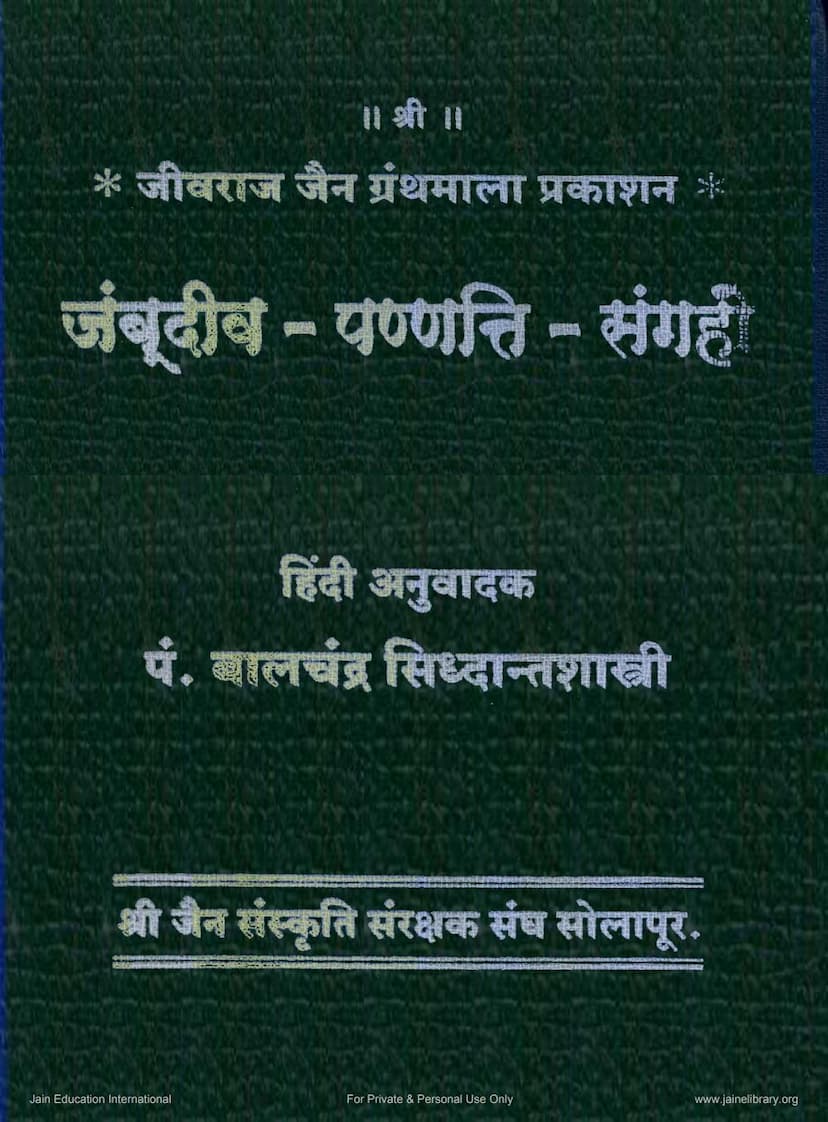Agam 18 Upang 07 Jambudveep Pragnapti Sutra
Added to library: September 1, 2025

Summary
The Jambudveepa Prajnapti Sutra (Agam 18, Upang 07) is a significant Jain text, authored by Padmanandi, edited by A.N. Upadhye and Hiralal Jain, and published by Shri Jain Sanskriti Sanrakshak Sangh, Solapur. The text, which deals with Jain cosmography and other related subjects, is presented here in its original Prakrit with a Hindi translation, critical notes, and appendices.
The book is structured into thirteen chapters, each covering various aspects of Jain cosmology and mathematics:
-
Chapter 1 (Upoḍghāta Prasthāva): This introductory chapter sets the stage for the text, offering salutations to the five Parmeshthins and outlining the author's intention to present the traditional teachings of Jain cosmography. It also provides a general description of Jambudveepa, its measurements, and geographical features like mountains, rivers, and Jin images.
-
Chapter 2 (Bharatairāvatavarnana): This chapter details the seven Kshetras (regions) of Jambudveepa, namely Bharata, Hairavata, Hari, Videha, Ramya, Haierana, and Airavata. It also describes the six Kulaparvatas that divide these regions and extensively covers the Vijayardha mountain with its Vidyadhara towns and Jin temples. The chapter mentions the different ages (Susama, etc.) and the religious inclinations of the inhabitants.
-
Chapter 3 (Parvatamudbhumi Varnana): This chapter focuses on the Kulaparvatas, their peaks, and the temples located on them. It also describes the glories of deities dwelling in lotus temples in lakes on these mountains and the presiding deities of Jambudveepa trees. The flow of the Ganga river is also described.
-
Chapter 4 (Mahavidehadhikara): This chapter begins with the description of the Mandara mountain, which stands at the center of Jambudveepa. It details the parks like Nandana on the mountain, adorned with gorgeous Jin temples, and the birth consecration of a Tirthankara celebrated by gods in the Panduka park. It also touches upon the military glories of Sudharmendra.
-
Chapter 5 (Mandargiri Jinabhavana Varnana): This chapter provides a detailed description of the Jinabhavanas on the Mandara mountain, including their dimensions, decorative items, worship articles, and architectural sectors. It mentions the worship carried out by various Indras.
-
Chapter 6 (Devakuru-Uttarakuru-Vinyasa Prasthara): This chapter elaborates on the Devakuru and Uttarakuru regions, describing their mountains, rivers, lakes, resident deities, and trees. It also names the various Nagakumara clans and their dwelling places.
-
Chapter 7 (Kachchavijaya Varnana): This chapter describes the Videha Kshetras located between the Nishadha and Nila Kulaparvatas. It discusses the division into Khandas, including Aryakhanda and Mlecchakhandas, and the glories of the Cakravartins who dwell there. It also mentions the three varnas present and their devotion to Jinas.
-
Chapter 8 (Purvavideha Varnana): This chapter describes the Purvavideha region with reference to its mountains, rivers, territories, and capitals.
-
Chapter 9 (Aparavideha Varnana): This chapter describes the Aparavideha region, focusing on its mountains, rivers, territories, and capitals. It also mentions the twenty Vaksara-parvatas on the banks of these rivers, whose peaks are adorned with Jin temples.
-
Chapter 10 (Lavana Samudra Varnana): This chapter describes the Lavana Samudra, which surrounds Jambudveepa. It notes its dimensions, the Patalas within it, and the seasonal tides. It also mentions the Velamdhara mountains and the Antardveepas inhabited by strange beings with abnormal habits.
-
Chapter 11 (Bahira Upasamhara Dveepa-Sagara-Naraka-Gati-Deva-Gati-Siddhaksetra Varnana): This chapter discusses oceans, islands, and the lower and upper worlds. It gives detailed measurements of the Dhataki Khanda and the surrounding oceans. It also elaborates on the regions and residents of the upper and lower worlds, influenced by Punya and Papa.
-
Chapter 12 (Jyotir-Loka Varnana): This chapter describes the Vimanas of the Jyotisa (astral) regions, the number of moons for different regions, and the lifespan of astral gods.
-
Chapter 13 (Pramana Pariccheda): This concluding chapter enumerates and defines various units of Time and Space, discussing their application in different aspects of life. It also expounds the means of valid knowledge to establish the validity of omniscience and sheds light on different forms of knowledge. It emphasizes the glories of an omniscient divinity.
The introduction also includes a section on the author, Padmanandi, discussing his lineage and the historical context of his composition, placing it likely after the 10th century AD and before 1461 AD, the date of the earliest known manuscript. The editorial remarks by H.L. Jain and A.N. Upadhye highlight the challenges faced in editing and publishing this complex text, including manuscript defects and printing delays. They also acknowledge the significant contribution of Prof. Lakshmichandra Jain in analyzing the mathematical aspects of the text, comparing them with Greek and Chinese writings. The publication aims to rescue this valuable work from oblivion and make it accessible for critical study.